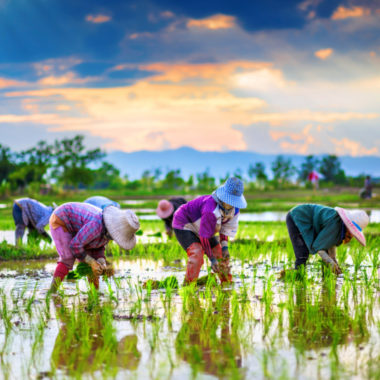Intro to Smart Technology, the technological revolution of agriculture is here.
Particularly in the context of climate change and a growing global population, the role of emerging technology in the farming industry will be critical to the success and thriving of future generations.
In fact, when looking at the numbers, the importance of smart technology in agriculture becomes abundantly clear. According to the United Nations, the world’s population is expected to hit 9.7 billion by 2050, with it potentially ballooning to nearly 11 billion by the turn of the century.
This means that future generations will potentially need to produce as much as double the quantity of food we do today, all while balancing the finite resources the world has such as land and water.
This is where smart farming technology can help. With as much as $22.3 billion being invested into the space in 2020, the opportunities new tech can offer farmers could be essential to the future of the industry.
Here are five examples of how smart technology is taking the modern farming industry to the next level of innovation.
Seeds from above
In April 2020, drones created by Chinese manufacturer XAG organised a rice seeding demonstration in the Guangdong province. The demonstration first involved workers planting 5kg of rice seeds the traditional way, this taking 25 minutes across a 1,200 square metre paddy field.
The demonstration then saw the XAG XPlanet drone do the same task in a mere 120 seconds. Given this example, the impact that drones could have on the speed and efficiency at which modern farmers operate cannot be understated.
Aside from the efficiency gains these devices offer, they’re also more environmentally friendly than traditional rice planting methods. XAG reported that their army of drones could use up to 90% less water and 30% fewer chemicals than manual techniques.
Keeping resources fresh
Considering that farms can be dispersed over a massive network of locations, keeping tabs on the quality and lifecycle of resources can be a tricky task.
However, with the help of connected technologies, farmers can receive real-time information on the state of their resources and products, preventing any unnecessary wastage.
A prime example of this is a product called GrainSafe, developed by Telesense. By dropping this ball-like device into a pile of grain, farmers can receive real-time information on the temperature and humidity the grain sits in.
Using this information, farmers can tweak conditions to ensure their resources are stored in optimal conditions at all times, extending the lifespan of these goods.
Caring for livestock with robots
Livestock are an essential part of farming life and, in most cases, require high levels of attention from farmers, with farms caring for potentially millions of animals throughout the year.
With this in mind, farmers are always keen to find tools that can help care for the vast quantities of animals they own. Today, many farmers are using robotics to help manage their livestock.
In Barcelona, Spanish start-up Faromatrics has created a robot which farmers can use to monitor their chicken farms remotely. Called The ChickenBoy, the robot glides along fitted rails to measure the temperature, air quality, light and sound that the chickens are housed in.
The ChickenBoy can even send mobile alerts to farmers via a cloud platform, keep farmers up to date on how their poultry pals are getting on in the coop.
Keeping farms connected
The primary challenge that smart farming technology has faced to date is the issue of connecting the devices and sensors to feed information back to farmers. In most cases farms are based in remote, rural locations spread out over a large area.
This is where 5G can be of help. Providing low-latency connectivity, 5G has the potential to connect 100 times more devices per square kilometre than 4G, as well as moving data 100 times faster.
5G-enabled farming is already catching on in some places. In Norway, the Sinkaberg Hansen Gjerdinga island fish farm is using 5G farming to its full potential. By combining the flexibility offered by 5G with high resolution cameras, fish farmers at the island can monitor up to one million fish, even in the darkest days of winter or the murkiest of waters.
Promoting better soil health
Pests and diseases have been a thorn in the side of farmers for thousands of years, leading to many underperforming harvests. In many cases, these can be found in the soil in which crops are planted.
So how can farmers protect their crops more effectively from these issues? With the help of smart technology, of course!
Better known for its work in medicine and churning through vast data sets to detect signs of disease, organisations are now applying machine learning algorithms to agriculture. For example, Pattern Ag, a soil biology company, is using machine learning tech analyse soil samples to detect signs of diseases and pests. What’s more, aside from detecting the problem, Pattern Ag’s technology can also suggest how to best eliminate the issue by recommending the correct herbicides to use in specific quantities.
As with other applications of smart technologies, farmers can save time and resources when working their lands. Pattern Ag estimates that 55% of US fields are protected with rootworm insecticides even though just 18% are at economic risk, meaning many applications of insecticides are unnecessary and wasteful.
With the help of machine learning, farmers can hit peak efficiency when it comes to applying protective chemicals to ward off disease and pests from their crops. For example, IoT Agriculture company DTN has developed a wireless ‘smart trap’ to help farmers protect their crops. These are fitted with pheromones that monitor the population of pests in real time, which can be seen from the farmer’s app on their phone. By automating the standard error-prone process that determines the amount of pesticide required, the company hopes to mitigate $20 billion dollars’ worth of damages in the US caused by crop pests.
Furthermore, our customer EFOS d.o.o. has also developed a solar-powered pest monitoring solution called Trapview, which uses integrated LTE connectivity to collect and analyse data. You can read more about it here.
Using machine learning and automation in farming results in a more environmentally friendly and more efficient farming system.
Interested and want to learn more about the role of smart technology in enabling innovation in the food sector? Leave a comment below and make sure to also follow us on Twitter at @ThalesIoT!



